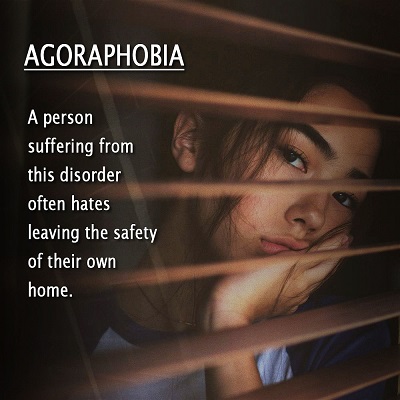 Agoraphobia is a type of anxiety disorder, characterized by the fear and avoidance of situations where escape may be difficult. A person suffering from this disorder often hates leaving the safety of their own home, as they have a huge fear of going out into open or crowded areas. They may also feel extremely anxious in case they can’t seek help if something terrible happens.
Agoraphobia is a type of anxiety disorder, characterized by the fear and avoidance of situations where escape may be difficult. A person suffering from this disorder often hates leaving the safety of their own home, as they have a huge fear of going out into open or crowded areas. They may also feel extremely anxious in case they can’t seek help if something terrible happens.
Some of the known fears and anxieties include open spaces, traveling via public transportation, going out of their home, or going into a shopping mall. People with agoraphobia try to avoid certain places or situations that may cause them to be put in danger (in their eyes), or make them feel trapped and helpless.
They find it difficult to feel safe in a crowded area and if they go to public places they must go with a trusted friend to avoid their overwhelming fear of disaster or embarrassment. This is why many people with agoraphobia often choose to never leave their homes. Unfortunately, the more they do stay in their home, the worse their condition can become.
Agoraphobia is the fear of being out in the open and feeling vulnerable to the world, and it is a real condition that can trigger severe anxiety and panic attacks and therefore, needs therapy and treatment.
Causes of Agoraphobia
Agoraphobia may develop as a complication of an anxiety disorder known as panic disorder. This typically involves overwhelming and intense fear that induces panic attacks.
Inherited genes and certain health conditions may trigger and worsen agoraphobia. Environmental stressors also have a role to play in it, including temperament and past experiences. A traumatic incident may be enough to contribute to the development of agoraphobia.
Signs and Symptoms of Agoraphobia
The common signs and symptoms of a person suffering from agoraphobia include the following:
- Fear of leaving home. They find it difficult to walk out their front door.
- The fear and anxiety of being alone in a public area.
- The fear of finding themselves surrounded by many people. Crowds are frightening to them.
- Being in an open area, especially if they feel that there is no help available if they need it.
- Fear of being trapped, such as in an elevator or small space.
- Taking public transportation can be terrifying to them.
Exposure to these types of situations is enough for people with agoraphobia to trigger a panic attack. Even if there is no actual reason for them to feel scared or anxious, their own anxious feelings and thoughts will cause them significant distress.
Women are more likely to be diagnosed with agoraphobia than men, although many men suffer from this disorder. This condition may develop in childhood, but it typically develops in the younger adult years.
Diagnosis and Treatment
Agoraphobia is an anxiety disorder that needs treatment early to keep symptoms from escalating and becoming worse. The longer agoraphobia stays untreated, the harder it is to manage. This condition can significantly affect a person’s life, making it very difficult to function normally. It can make simple everyday tasks and errands nearly impossible to accomplish.
Getting diagnosed with agoraphobia begins by closely looking at the typical signs and symptoms in behavior. A licensed mental health physician will be responsible for diagnosing a patient with agoraphobia. A physical exam will help rule out any physical health conditions, and an in-depth interview with your physician or mental health specialist will be part of the diagnosis.
The most effective treatments include psychotherapy. In some cases where the need is recognized, taking medications as prescribed by the doctor will be necessary. Medications for treating agoraphobia may include antidepressants and anti-anxiety medications.
Alternative medicine may also prove to be helpful and some may bring similar results to prescription drugs. Whatever medicines, natural or prescription, are taken as part of the treatment, should always be discussed with your health professional.
Treatment is a must and should be taken with safety measures in place to avoid further escalation of the symptoms becoming worse.





